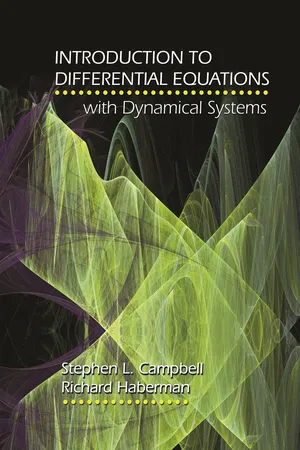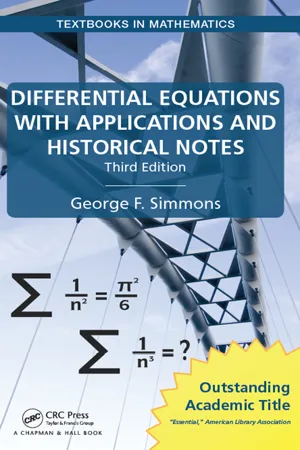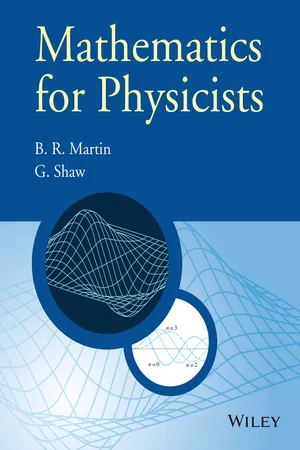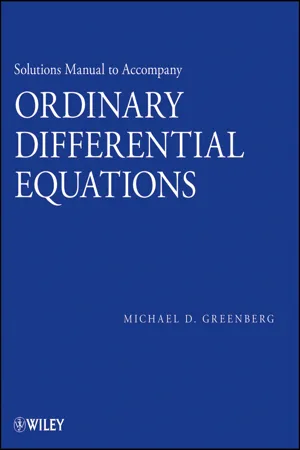Mathematics
Coupled First-order Differential Equations
Coupled first-order differential equations refer to a system of two or more first-order differential equations that are interconnected and influence each other's behavior. These equations are typically solved simultaneously to find a solution that satisfies all of them. Coupled systems often arise in various fields of science and engineering, and their solutions can provide valuable insights into complex dynamic systems.
Written by Perlego with AI-assistance
Related key terms
Related key terms
1 of 4
Related key terms
1 of 3
8 Key excerpts on "Coupled First-order Differential Equations"
- Stephen L. Campbell, Richard Haberman(Authors)
- 2011(Publication Date)
- Princeton University Press(Publisher)
CHAPTER 1
First-Order Differential Equations and Their Applications
1.1 Introduction to Ordinary Differential Equations
Differential equations are found in many areas of mathematics, science, and engineering. Students taking a first course in differential equations have often already seen simple examples in their mathematics, physics, chemistry, or engineering courses. If you have not already seen differential equations, go to the library or Web and glance at some books or journals in your major field. You may be surprised to see the way in which differential equations dominate the study of many aspects of science and engineering.Applied mathematics involves the relationships between mathematics and its applications. Often the type of mathematics that arises in applications is differential equations. Thus, the study of differential equations is an integral part of applied mathematics. Applied mathematics is said to have three fundamental aspects, and this course will involve a balance of the three:- The modeling process by which physical objects and processes are described by physical laws and mathematical formulations. Since so many physical laws involve rates of change (or the derivative), differential equations are often the natural language of science and engineering.
- The analysis of the mathematical problems that are posed. This involves the complete investigation of the differential equation and its solutions, including detailed numerical studies. We will say more about this shortly.
- However, the mathematical solution of the differential equation does not complete the overall process. The interpretation of the solution of the differential equation in the context of the original physical problem must be given, and the implications further analyzed.
Using the qualitative- eBook - ePub
- Clayton R. Paul(Author)
- 2011(Publication Date)
- Wiley-IEEE Press(Publisher)
4Solution of Linear, Constant-Coefficient, Ordinary Differential EquationsEngineering systems have inputs that are usually functions of time, denoted as t. Static engineering systems are generally governed by algebraic equations. Dynamic engineering systems are generally governed by differential equations. These differential equations contain derivatives with respect to time t and are somewhat more difficult to solve than are algebraic equations. In this chapter we examine the most common type of differential equation that is frequently found in engineering systems: the linear, constant-coefficient, ordinary differential equation.4.1 HOW TO IDENTIFY LINEAR, CONSTANT-COEFFICIENT, ORDINARY DIFFERENTIAL EQUATIONSWhat do they look like? In these equations there is only one independent variable, which we denote as t (perhaps symbolizing time). The function to be solved for is denoted as x(t). Since the unknown is a function of t, any derivatives will be with respect tot: dx(t)/dt, d2 x(t)/dt2 ,and so on. These are said to be ordinary derivatives, as opposed to partial derivatives. A derivativedn x(t)/dtnis said to be of order n.The general form of a first-order ordinary differential equation is(4.1a)The general form of a second-order ordinary differential equation is(4.1b)The coefficients a and b are constants and are known (given). The right-hand-side function of t,f(t), is also known (given). The right-hand side,f(t), is called the forcing function since it represents the source that is driving the engineering system. The task will be to solve for a function x(t) which when substituted into the equation, satisfies it. It is always a good idea to make the leading coefficient unity I All of our results apply, of course, in identical fashion to differential equations where the independent and dependent variables might have different symbols and meanings, such as y(x). - eBook - ePub
Mathematical Modeling
Branching Beyond Calculus
- Crista Arangala, Nicolas S. Luke, Karen A. Yokley(Authors)
- 2018(Publication Date)
- Chapman and Hall/CRC(Publisher)
t is an independent variable. Furthermore, in an introductory differential equations course, we learned that a differential equation is any equation that contains a derivative, or differentials. Because differential equations can be used to define derivatives, or rates of change, they can be used to model virtually any quantity or system that changes over time. In this chapter, we’ll discuss how to build and solve a variety of differential equations models.When creating a differential equations model, the goal is to derive a mathematical representation of how a quantity of interest is changing. This quantity is the dependent variable in the equation, and is referred to as a state variable or state of the model. The independent variable from the differential equation usually represents a physical attribute such as time or distance. Other parameters or constants that are present within the model are referred to as parameters.Recall that a differential equation that is coupled with a set of additional constraints on the dependent variable and its derivatives at a particular input (called initial conditions) is called an initial value problem. When constructing a mathematical model using a differential equation, it is desirable to create a model that has a single unique solution rather than a family of solutions. Because of this aspect of the modeling process, the majority of the differential equations models that we will construct or encounter will be initial value problems. While modeling with differential equations, we may also encounter boundary value problems, which consist of a differential equation with additional constraints on the dependent variable and/or its derivatives at different inputs (called boundary conditions).Within the next sections of this chapter, we will discuss how to construct and solve differential equations models. One aspect of the construction process that we won’t discuss very much is the importance of making units match. When formulating a differential equation that will be used to represent physical processes, we must keep in mind that the units of the model must match the units of the physical process. For example, consider the following equation that is part of an SVIR disease model, - George F. Simmons(Author)
- 2016(Publication Date)
- Chapman and Hall/CRC(Publisher)
Chapter 10 Systems of First Order Equations 54 General Remarks on Systems One of the fundamental concepts of analysis is that of a system of n simultaneous first order differential equations. If y 1 (x), y 2 (x),…, y n (x) are unknown functions of a single independent variable x, then the most general system of interest to us is one in which their derivatives y ′ 1, y ′ 2, …, y ′ n are explicitly given as functions. of x and y 1, y 2,…, y n : y ′ 1 = f 1 (x, y 1, y 2, …, y n) y ′ 2 = f 2 (x, y 1, y 2, …, y n) ⋯ y ′ n = f n (x, y 1, y 2, …, y n). (1) Systems of differential equations arise quite naturally in many scientific problems. In Section 22 we used a system of two second order linear equations to describe the motion of coupled harmonic oscillators; in the example below we shall see how they occur in connection with dynamical systems having several degrees of freedom; and in Section 57 we will use them to analyze a simple biological community composed of different species of animals interacting with one another. An important mathematical reason for studying systems is that the single n th order equation y (n) = f (x, y, y ′, …, y (n − 1)) (2) can always be regarded as a special case of (1). To see this, we put y 1 = y, y 2 = y ′, …, y n = y (n − 1) (3) and observe that (2) is equivalent to the system y ′ 1 = y 2 y ′ 2 = y 3 … y ′ n = f (x, y 1, y 2, …, y n), (4) which is clearly a special case of (1). The statement that (2) and (4) are equivalent is understood to mean the following: if y (x) is a solution of equation (2), then the functions y 1 (x), y 2 (x),…, y n (x) defined by (3) satisfy (4); and conversely, if y 1 (x), y 2 (x),…, y n (x) satisfy (4), then y (x) = y 1 (x) is a solution of (2). This reduction of an n th order equation to a system of n first order equations has several advantages- eBook - ePub
- Brian R. Martin, Graham Shaw(Authors)
- 2015(Publication Date)
- Wiley(Publisher)
In physical situations, these constants are fixed by specifying boundary conditions, that is, by requiring that y and/or its derivative has specific values at given points. For example, the linear second-order equation has the general solution which may be verified by direct substitution. A and B are two arbitrary constants, as expected for a second-order equation. To determine these, we could specify the values of y at two values of x. Thus, if we were to require that y = 0 when x = 0 and y = 1 when x = 1, then which gives and hence the specific solution is Different boundary conditions lead of course to different solutions. In the following sections we will discuss a number of methods to solve various types of ordinary differential equations, starting with first-order equations of the first degree. First-order equations of higher than first degree rarely occur in physical science and will not be discussed here. 14.1 First-order equations The general form for equations of this type is (14.4) Solutions of (14.4) are found relatively easily if F (x, y) has specific simple forms and we will discuss some of these below. 14.1.1 Direct integration If F (x, y) = f (x) is a function of x only, then (14.4) takes the form (14.5a) and may be directly integrated to give where c is an arbitrary constant. If F (x, y) = f (y) is a function of y only, then we have (14.5b) so that the solution is again obtained by direct integration. Example 14.1 The number of particles N in a radioactive sample decreases at a rate d N /d t = −α N, where α > 0. If N = N 0 at time t = 0, how many particles remain at time t? Solution With a trivial relabelling, the equation for the decay rate is of the form (14.5b) so that and hence where c is a constant - eBook - ePub
- Wim van Drongelen(Author)
- 2018(Publication Date)
- Academic Press(Publisher)
Chapter 9 Differential Equations Introduction Abstract In this chapter we review ordinary differential equations (ODEs) as a tool to model dynamics. We present examples of how to formulate them based on the dynamical system that needs to be modeled, and demonstrate the mathematical techniques one can employ to solve the equation analytically. We show how to solve linear differential equations with and without a forcing term, the so-called inhomogeneous and homogeneous ODEs, respectively. To illustrate the analysis of these equations, ODEs with first-order derivatives (e.g., d c / d t) and second-order derivatives (e.g., d 2 c / d t 2) are used in the examples. Next, we show how higher-order ODEs can be represented as a set of first-order ones, and how this leads to a formalism in matrix/vector notation that can be efficiently analyzed using techniques from linear algebra. To complete the overview of the available tools for solving ODEs, the final part of this chapter briefly refers to application of Laplace and Fourier transforms (see also Chapter 12) to solve them. Keywords Characteristic equation; Dynamics; Eigenvalue; Forcing term; Linear homogeneous equation; Linear inhomogeneous equation; Ordinary differential equation (ODE) 9.1. Modeling Dynamics When modeling some aspect of a neural system, we can represent static variables with algebraic expressions, e.g., the concentration c of some chemical in the brain is 10 units, c = 10. Of course, we can make these expressions a bit more complicated; for instance, the concentration could also depend on some combination of other substances a 1 and a 2 : e.g., c = 5 a 1 + a 2 + 10. It is important to realize that the variables do not change with time or space. For that reason the value of this type of equation is limited to situations where we study properties that remain constant over the range and duration of our interest - Michael D. Greenberg(Author)
- 2014(Publication Date)
- Wiley(Publisher)
CHAPTER 1
First-Order Differential Equations
Section 1.1
This first section is simply to introduce you to differential equations: what they look like, some ideas as to how they arise in applications, and some important definitions. We see that the complete problem might be not just the differential equation, but also one or more "initial conditions." If such conditions are prescribed, the problem is called an initial value problem, or IVP. For instance, (6) [that is, equation (6) in the text] is an IVP because in addition to the DE (differential equation) there are two initial conditions, given by (6b), so that the solution of the IVP must satisfy not only the DE (6a), but also those two initial conditions.Chapter 1 is about first-order equations; that is, equations in which the highest derivative is of first order. In that case, hence all through Chapter 1, there will be only one initial condition. In later chapters we will find that the "appropriate" number of initial conditions for a DE is the same as the order of the equation. For instance, (6a) is of second order and, sure enough, there are two initial conditions in (6b).The distinction between linear and nonlinear differential equations will be of great importance, so it is necessary to be able to tell if a given equation is linear or nonlinear. Later, we will find that the key is whether or not a certain linearity property is satisfied, but for now it will suffice not to know about that property, but simply to say that an nth-order equation is linear if it is in, or can be put into, the form (14). What is the form of (14)? First, put all occurrences of the unknown, that is, the dependent variable such as y in (14), on the LHS (left-hand side of the equation); anything else goes on the right. If the LHS is a linear combination of y, y ',…, y(n ), then the DE is linear. Actually, the "constants" that multiply y, y ',…, y(n )in (14) are permitted to be functions of x ; the point is that they don't depend on y- eBook - ePub
Advanced Problem Solving with Maple
A First Course
- William P. Fox, William C. Bauldry(Authors)
- 2019(Publication Date)
- Chapman and Hall/CRC(Publisher)
kv. We then would have the modelF =F p+F d+F bF =m a = my ″=− m g + k vwith the same initial conditions y(0) = h, y′(0) = 0.In this chapter, we will consider a variety of models, concepts, and techniques that give the reader some of the basic tools needed in solving and analyzing first-order differential equations. Since differential equations are used often in solving problems related to continuous change, we devote a more thorough approach in this chapter.Section 2.2 provides some models that we will solve and analyze. These models come from a variety of disciplines in science and engineering, including chemistry, physics, biology, fluids mechanics, Newtonian Mechanics, environmental engineering, and financial mathematics. Modeling techniques are discussed that help determine the necessary coefficients in the models.Section 2.3 introduces slope fields. Slope fields provided a qualitative view of solutions of first-order differential equations. Recall that we said this book discusses the modeling of change. Slope fields provide information about rates of change since they are derived from information given by the derivative.Section 2.4 covers the analytical method of solution with Maple. Existence and uniqueness are addressed from conceptual and theoretical bases. The focus is on the initial-value problem and the question as to whether or not the initial value problem has a unique solution, and whether new functions can be defined by the initial-value problem.Section 2.4 investigates the special class of ODEs called linear differential equations.Section 2.5
Index pages curate the most relevant extracts from our library of academic textbooks. They’ve been created using an in-house natural language model (NLM), each adding context and meaning to key research topics.
Explore more topic indexes
Explore more topic indexes
1 of 6
Explore more topic indexes
1 of 4







